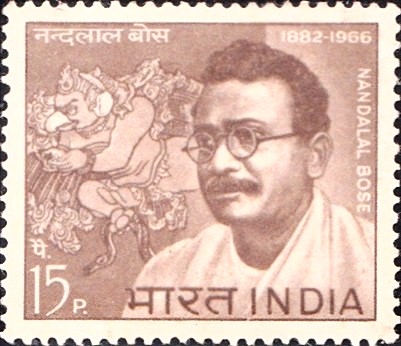
Nandalal Bose 1967
A commemorative postage stamp on Acharya Nandlal Basu, an Indian Bengali painter, a key figure of Contextual Modernism :
 Issued by India
Issued by India
Issued on Apr 16, 1967
Issued for : On the occasion of the first anniversary of his passing away, the Indian Posts and Telegraphs Department is privileged to issue a special commemorative stamp to honour Acharya Nandalal Bose, who was great as an artist, as a teacher and as a human being. This stamp, apart from carrying a portrait of the great painter, also depicts one of his famous works, “Garuda“.
Design : The painting “GARUDA” has been reproduced in the stamp with the permission of the heirs of the late Shri Nandalal Bose, by the courtesy of M/s. George G. Harrap & Co. Ltd., London.
Type : Stamp, Mint Condition
Colour : Dark Brown
Denomination : 15 Paisa
Overall Size : 3.34 X 2.88 cms.
Printing Size : 2.99 X 2.52 cms.
Perforation : 14 x 13½
Watermark : Printed on unwatermarked paper
Number Printed : 20,00,000
Number per issue Sheet : 42
Printing Process : Photogravure
Designed and Printed at : India Security Press
Name : Nandalal Bose
Born on Dec 3, 1882 at Tarapur, Munger, Bihar, India
Died on Apr 16, 1966 at Kolkata, India
About :
- Born on December 3, 1882, Nandalal Bose was one of the greatest masters to appear in the wake of the Bengal Renaissance. He led the art movement in India in its voyage of rediscovery, and, in the process, spanned the gulf between the traditional and the modern. But for the forward path shown by him, contemporary Indian art could not probably have been where it is to-day. His passing away on April 16, 1966, marked the end of an era.
- Nandalal joined the Calcutta Art School in 1905 when Abanindranath Tagore was its Vice-Principal. His association with the Tagores greatly influenced his early life. He joined Rabindranath at Santiniketan in 1919 and became the Principal of Kala Bhavan in 1922. In the ideal setting of Kala Bhavan where the community lived amidst nature, the philosophical and educational ideas of the Poet must have inspired Nandalal to relate creative art to everyday life. His love of traditional art took him to Ajanta and the Bagh Caves. He also became acquainted with the Okakura Group of Japan. He visited China, Japan, Malaya, and Burma, and later on Ceylon, to imbibe the spirit of the rich artistic heritage of Asia. An admirer of Gandhiji, he was close to the Mahatma.
- Nandalal‘s early paintings were in wash. Later, he worked in tempera. His mastery of the Indian tradition is reflected in the ‘Ramayana scenes‘, ‘Nala-Damayanthi‘, ‘Agni‘, etc., while his own individualistic style is seen in ‘Jagai Madhai‘ and ‘Gokul Brata‘. His paintings on Puranic themes support even today the reputation he enjoys. At Santiniketan, one sees the attempts at a bolder technique, the formal composition is subordinated to the wielding of the brush, as in ‘Basant‘ (Spring), ‘Dupur‘ (Midday) and ‘Sandhya‘ (Dusk). Side by side, tradition is kept alive in works like ‘Kurukshetra‘, ‘Arjun‘, etc. The years 1930-40 were full of vigour and vitality; ‘Svarna Khumba‘ (Golden pot), ‘Landscape‘ and ‘Savarir Pratiksha‘ (Waiting of Savari) reveal sculpturesque strength, simplicity and architectural qualities.
- A call from Gandhiji to place the work of art before the common man brought out the famous Haripura Congress posters in bright colours and sharp calligraphic lines depicting folk musicians, artisans and agricultural workers. Speed of calligraphic lines, comprehensive decorative character, simple construction, economical use of colour, these are the qualities of the mature phase of the artist’s life, as seen from the series on the life and scenes at Puri and Gopalpur. While well on his way to 80, Nandalal again started painting with brush and ink, not so much to express any specific feeling or idea, as to suggest some abstract aspect of realisation, the subjects being mere pretexts.
- If Abanindranath was ethereal and romantic, his disciple Nandalal represented a more classic phase of the Bengal School. Nandalal‘s art had a deep reference to life and reality, while at the same time reflecting his innate sense of design. The vast array of techniques and medium speak for his versatility. His innumerable paintings, graphics, illustrations and ornamental designs have immortalised him; on the other hand, hundreds of his students, some of them famous, keep alive what they learnt from him – art as a principle and way of life.


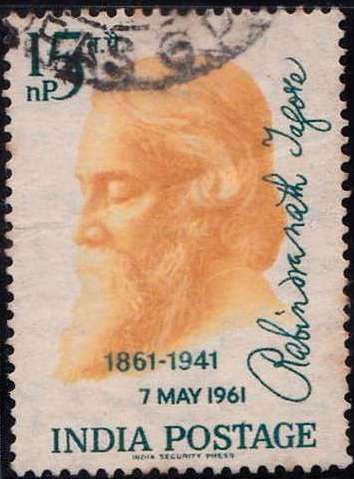
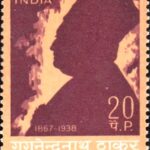
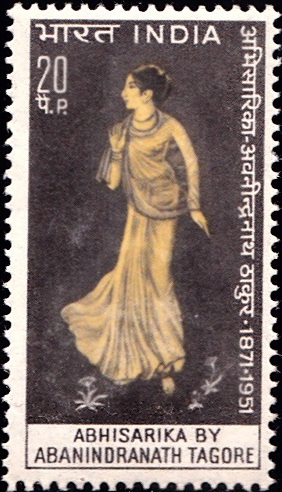
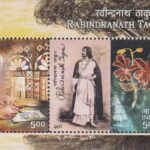
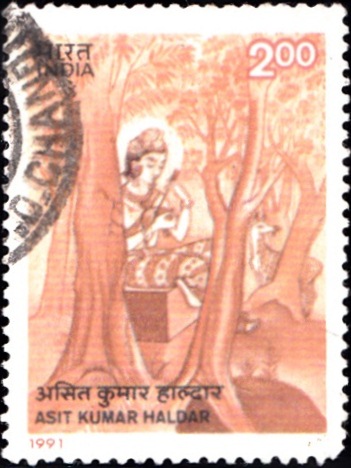
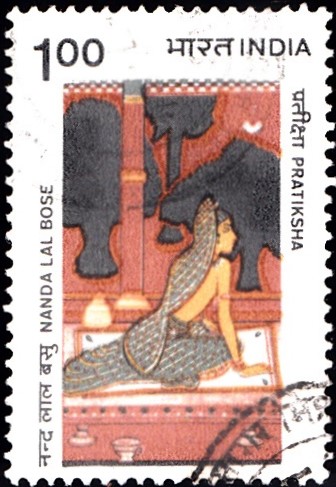
[…] activity ‘creation of small toys’, art works of sculpture made from found objects. Nand Lal Bose, Kshitindranath Majumdar and K. Venkatappa are among those who were inspired by Abanindranath, […]
[…] as Gokhale, Sri Aurobindo, Rabindranath Tagore, Jagdish Chandra Bose and the artist Nandalal Bose. True to her name of Nivedita which Swami Vivekananda had bestowed upon her, she was indeed the […]
[…] Gandhiji on the Dandi March Designed by : India Security Press on the basis of the wood-cut by Nandalal Bose Colour : Bronze Blue Denomination : Rs 1/- Overall Size : 4.06 X 2.28 cms. […]